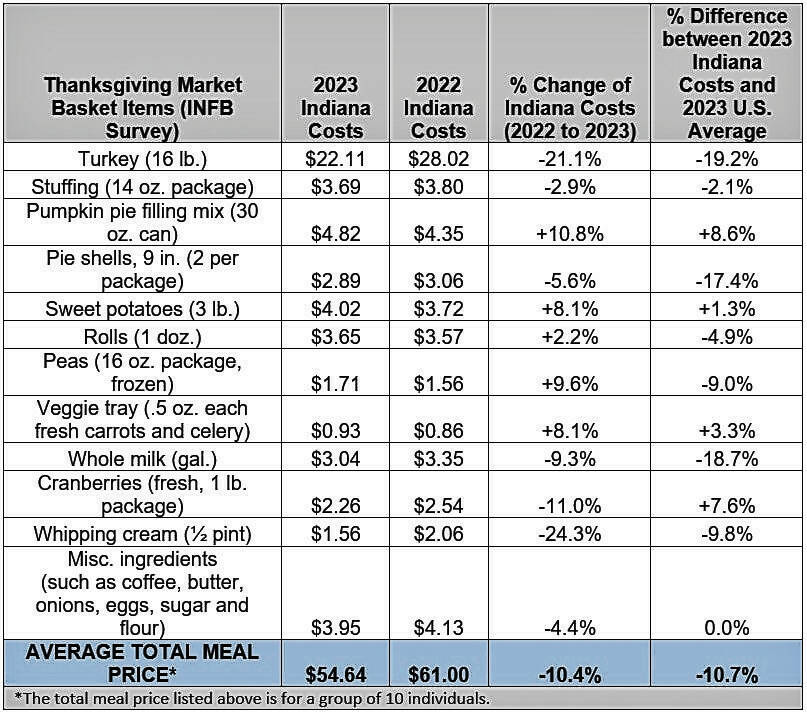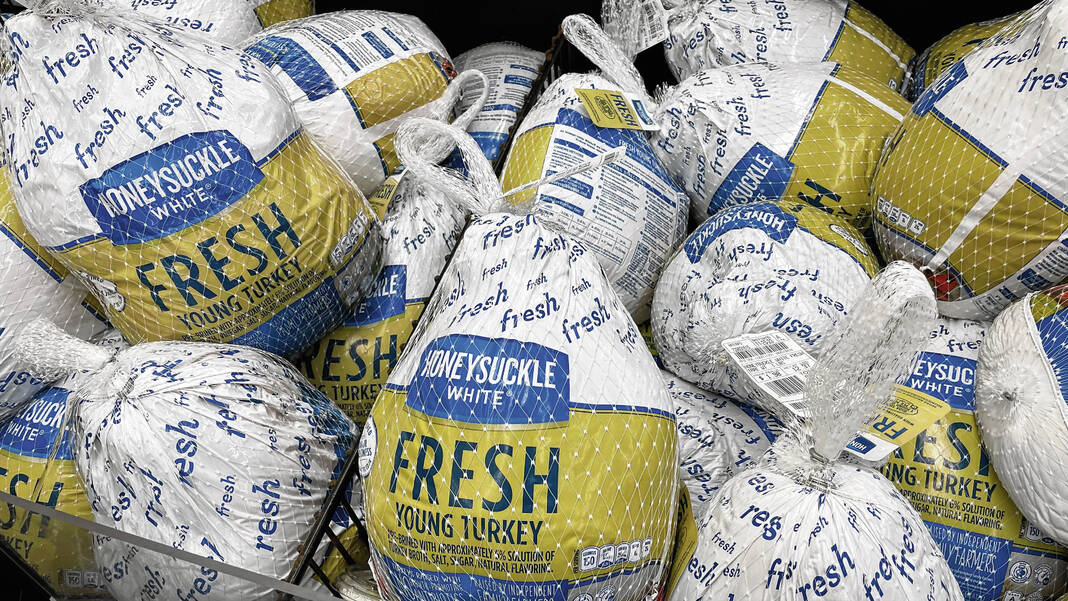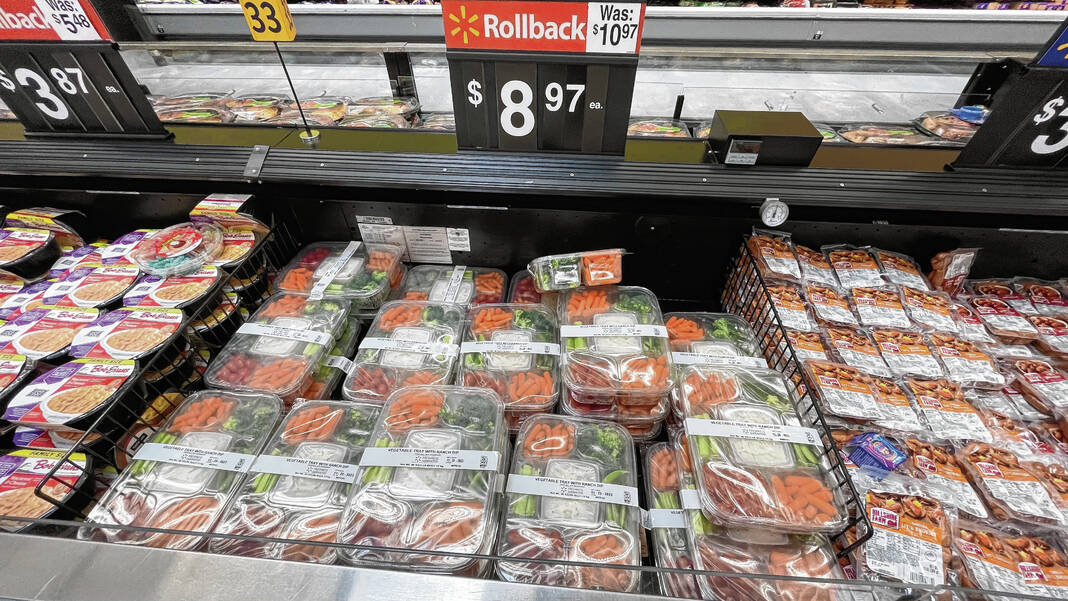While prices are still elevated due to inflation, Hoosier shoppers can expect to spend about 10% less on Thanksgiving groceries compared to 2022.
Hoosiers are paying an average of $54.64 for a Thanksgiving dinner for 10 people, or $5.46 per person, according to the Indiana Farm Bureau’s annual Thanksgiving market basket survey.
The survey was conducted in early November by volunteer shoppers, who collected prices on specific food items from one of their local grocery stores. They were asked to look for the best possible prices without using special coupons or purchase deals.
2023’s market basket includes a 16-pound turkey, stuffing, sweet potatoes, rolls, peas, a carrot and celery veggie tray, whole milk, cranberries, whipping cream, ingredients for pumpkin pie and miscellaneous baking items. Indiana’s market basket price also is approximately 11% lower, or 66 cents less, than the U.S. average price of $6.12 per person, the Indiana Farm Bureau, or INFB, said in a news release.
The main driver of the decrease for Hoosiers is a lower cost for turkey, INFB Chief Economist Todd Davis said in the news release. This year, shoppers can expect to pay approximately $1.38 per pound for a whole turkey, or $22.11 for a 16-pound bird — a decrease of about 21% from 2022. This is largely due to the dramatic reduction in avian influenza cases and a recovery of the turkey population in the U.S. and specifically the Midwest, which produces the most turkeys.
The Midwest had the least expensive market basket at an average price of $58.66, the INFB said.
“Three out of the five top turkey-producing states are located in the Midwest, with Indiana ranking fourth,” he said in the news release. “The concentration of turkey production in this region provides lower processing and marketing costs, which gets the turkey from the farm to the hands of the consumer efficiently.”
Over half of the items in the market basket are less expensive for Hoosiers than last year — most notably the turkey, whipping cream and cranberries. However, there were some items that increased in price, with the largest percentage price increase being for pumpkin pie filling mix and frozen peas, according to the INFB.
Only pumpkin pie filling, sweet potatoes, a veggie tray and cranberries are more expensive in Indiana this year than they are nationally. Among these items pumpkin pie filling has the highest difference, at about 9%, while sweet potatoes have the lowest at about 1%, data shows.
All other items in the market basket came in equal to or less than the national average, with the INFB noting turkey, whole milk and pie shells as examples. Compared to the national average, turkey is about 19%, whole milk is about 19% and pie shells are approximately 17% cheaper in Indiana this year.
Even though there’s been a decrease in the overall cost of a Thanksgiving meal, the INFB says Hoosiers are still paying 28% more than they were four years ago. This mirrors the U.S. average cost.
Citing the U.S. Bureau of Labor Statistics, the INFB says the food-at-home consumer price index, a measure of price changes at the grocery store, from January through October 2023 increased 4.9% year-over-year. For all of 2022, food-at-home annual costs increased 11.4%.
“Even though the rate of inflation is not as extreme as last year, the cumulative effect of food inflation is still very much present,” Davis said. “This includes the collective impact of labor, fuel, packaging and transportation costs, all of which are costs beyond the farm gate.”

Only 14 cents of every retail food dollar can be attributed to farm production, after accounting for input costs, according to the U.S. Department of Agriculture. With this figure in mind, the farmer’s share of the $54.64 market basket would be less than $8. The rest is for food processing, packaging, transportation, wholesale and retail distribution, and food service preparation, according to the INFB.
Additionally, droughts over the last few years have affected crops’ ability to grow, which drives up prices, along with high supply costs.
“It’s been a difficult few years for farmers in terms of high input costs and getting what we need to produce food, fuel and fiber for the world,” said Isabella Chism, INFB’s second vice president. “And the amount farmers are being paid hasn’t covered the increase of their input expenses. But Hoosier farmers continue to find ways to streamline their operations and decrease costs of production, and we are glad to see that this Thanksgiving will be a bit more affordable for consumers compared to last year.”
Food costs and consumer trends around the holidays were the focus of Purdue University’s Consumer Food Insights Report for October. Joe Balagtas, a professor of agricultural economics at Purdue University and the director of the Center for Food Demand, told the Associated Press in an interview that food price inflation last month was measured at 3.7%, which is the lowest point in two years.
“So inflation is starting to cool, and that’s a good thing,” Balagtas said. “Of course, cooling inflation doesn’t mean that prices are falling; it’s just that they’re rising at a lower rate.”
That report also found that 8-in-10 Americans plan to celebrate Thanksgiving with a big meal. Ninety-five percent of respondents said they would have a turkey as the centerpiece of their Thanksgiving meal.








